
The national movement looked local with an Earth Day action that took over a long-disputed tract of land in California’s East Bay and turned it into a community farm with two acres of planted crops. Monday morning, activists were removed by force, but they vowed to return.
Gopal Dayaneni climbed onto a truck, megaphone in hand, a straw hat shading his face as he spoke to the crowd gathered at the locked gates.
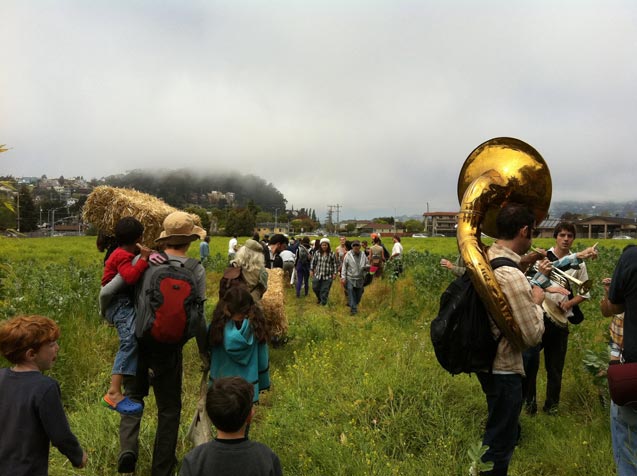 Farmers, young and old, took the tract on April 22, led by the Brass Liberation Orchestra.
Farmers, young and old, took the tract on April 22, led by the Brass Liberation Orchestra.
“If you’ve ever planted a seed, if you’ve ever pulled a weed, you are a farmer,” Dayaneni said. “I’m ready to walk through that gate and take back the tract.”
He continued: “Because if it is the right thing to do, then we have every right to do it.” The crowd cheered as the chains on the gates were cut open and hundreds flooded onto the Gill Tract, several acres of University of California (UC) property that have been contested for more than a decade. They brought tools, straw, chickens in portable coops and 15,000 starter plants that had been growing in green houses around Northern California for the past several months before finding their home in this Class I soil in the sleepy bedroom community of Albany, just north of Berkeley.
Three weeks later, police in riot gear raided the property, arresting nine activists, including Dayaneni.
A few months ago, when one activist approached me and whispered, “Save the date, we’re going to plant a garden,” this is not exactly the ending I had expected.
 Farmers set to work on April 22, unloading fresh compost for rows.
Farmers set to work on April 22, unloading fresh compost for rows.
The university contends that the farm has impeded high-stakes agricultural research projects set to begin in mid-May. The farmers contend that the University is placing profits ahead of the community’s interest in this last parcel of high-quality arable land in the developed East Bay. They point to the UC’s plan to develop the tract with a 35,000-plus square foot Whole Foods store and for-profit senior housing center. According to the UC’s proposed master plan, the space where activists’ crops now stand and UC scientists now research would be sodded for youth baseball diamonds and other recreational space.
For now, it’s just 70 well-trodden rows of hand-planted organic seedlings surrounded by police in riot gear.
The Gill Tract farm is unlike what most of the public has come to expect from Occupy: actions meant as protest, sending a message as a part of a broader demonstration against economic, political and societal ills. As it stands, the farm has sent a message about the privatizing of public universities and public land, genetically modified food stuffs, urban farming and food sovereignty.
But this message is secondary to the action. The farm is not only and not really a message – because it is a farm. Occupy has inserted itself into a long and protracted battle between a community and a privatizing public institution. If the University of California is forced back to the bargaining table with the community, Occupy actually stands to win.
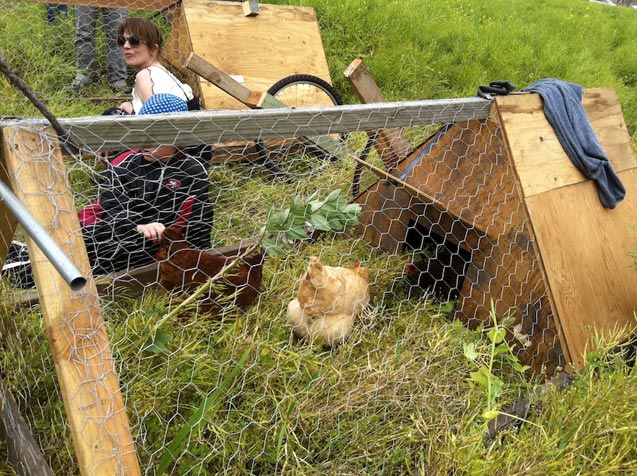 Two portable coops and four egg-laying chickens arrived at the farm on April 22.
Two portable coops and four egg-laying chickens arrived at the farm on April 22.
But that win comes at a cost. The rules of the public relations war dictate that first the farm must be bulldozed, the children’s garden razed, the farmers handcuffed and dragged out toward the cameras clustered at the locked gates. Then, perhaps, its message will be heard.
While some wiped away tears as university workers drove backhoes and dump trucks into the farm, one activist said she was happy the police had come. “It takes it to the next level,” she said, beaming.
For the last several years, the UC has raised tuition while suffering budget shortfalls and enacting on-campus austerity measures. In its 2012-2013 budget, the UC stated it “is exploring sources of additional revenues.” For the Gill Tract, those revenues have come in many forms, from partnerships with multinational Big Ag companies to long-term leases for big box retail.
 Farmers pull up overgrown mustard grass and roto-till the rows on April 22.
Farmers pull up overgrown mustard grass and roto-till the rows on April 22.
The University of California was founded with financial aid from legislation which established land-grant universities and “objective practical education in agriculture and landscape gardening.” It was in that spirit that the UC obtained the then 104-acre Gill Tract in 1928. Over the years, they established an agricultural research station while parceling out and developing the tract until only 15 acres were left.
That development faced little pushback until the late ’90s, when community groups, nonprofits and UC Berkeley professors began a campaign to turn part of the tract into “the world’s first university center on sustainable urban agriculture and food systems.” They toiled for years as the UC contracted with corporations such as Novartis and British Petroleum to share in discoveries made through tract research on genetic modification. “We feel this behavior represents a distinct bias within UC to favor global industrial agriculture at the expense of the people of California,” they wrote in 2000.
In 2002, another group attempted to begin the farm conversation again, this time with backing from the local teachers association, school district, mayor of Berkeley and farm-to-table food star Alice Waters, all to no avail.
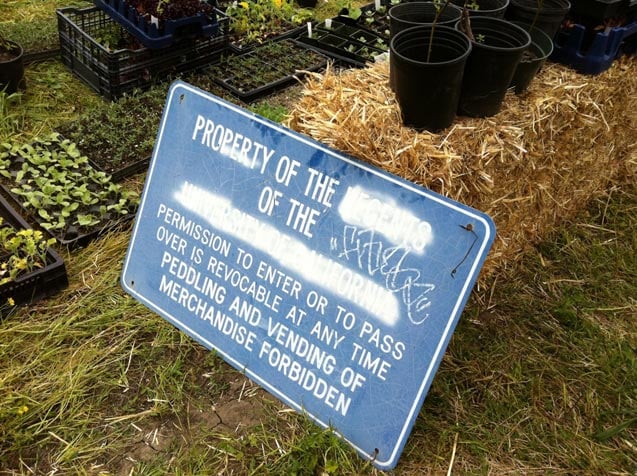 Removed signage at Occupy the Farm, April 22.
Removed signage at Occupy the Farm, April 22.
“We’ve been attempting to designate the Gill Tract as an agricultural easement for the past 15 years and the UC has stonewalled us,” Albany resident and Albany Farm Alliance member Tarina Larsen told me as police blockaded the tract. Larsen lives across the street from the farm. “I used to be 99.9% into this,” she said, looking at the lines of police. “Now I’m in it 150%.”
In a prime part of the East Bay where modest homes cost upward of a half-million dollars, the Gill Tract is an important holding for the UC. But as a part of the university’s “capital projects” venture, it’s unclear whether the tract is an important holding for the people of California as well – at least those outside tiny Albany.
Albany is but 1.7 square miles and 18,000 residents strong. Tax revenue from a Whole Foods could go far for this little town, at least farther than the zero dollars the UC currently pays. The farm lies less than a quarter mile from neighboring Berkeley, the residents of which would have no say and no stake in the development of the tract. Perhaps this is how Albany always would have wanted it: their town was founded in 1908 following a protracted battle adjacent to the Gill Tract over Berkeley residents hauling and dumping their garbage there. There was a shotgun stand-off at a nearby corner. On Monday morning, the shotguns were back at that corner, this time held by UC police officers.
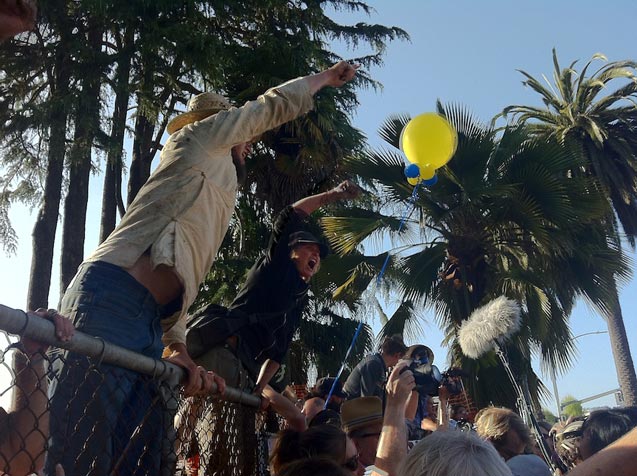 Police locked the gates on May 11 while farmers continued to work the fields inside the tract.
Police locked the gates on May 11 while farmers continued to work the fields inside the tract.
Shortly after UC police locked entrance and exit gates at the farm last Friday, UC Berkeley student and farm activist Marika Iyer perched on the perimeter fence and addressed the crowd. “This isn’t about Albany,” she said, gesturing toward the town. “This is about food sovereignty and sustainability for the whole bio-region.”
Urban and urban-adjacent agriculture produces about 30 percent of the US food supply. Food deserts in low-income communities prosper about as well as fruits and vegetables in the East Bay Area’s Mediterranean climate, and poor city residents can spend as much as half their income on food each year. Controlling even some of that income would mean the kind of food sovereignty farm activists speak of so glowingly.
“This is just an idea that seems to really be resonating in all different types of communities,” said Claiborne McDonald, a farm activist who has traveled across the country for the Occupy movement. “We’re out of agricultural land. We have run out. This is the end of it. And food sovereignty is a pretty old and new idea that I think people feel in their bones. We need food around us – we can’t import everything.”
But food sovereignty is not an issue Occupy the Farm could solve on its own. At best, the two acres activists planted with a variety of vegetables can produce a little more than 100 pounds of produce each week. Where the project’s real value lies, activists say, is in its educational power and example for nearby communities.
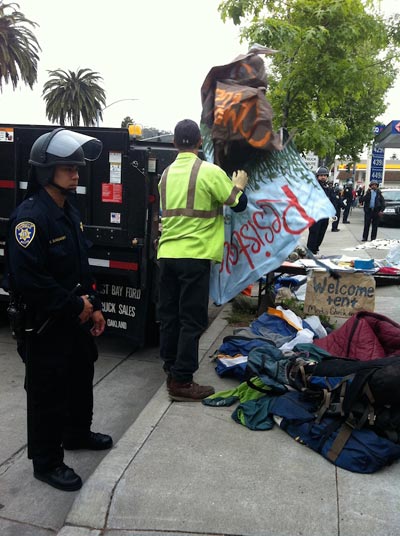 Albany city workers dispose of farm supplies on May 14.“Our vision for the future is to turn this into sort of a hub for urban agriculture,” said UC Berkeley student Lesley Haddock, who helped to plan this action for the past several months. “We’ve seen people trying the democratic process for 15 years. Those people are really frustrated. We’re sort of taking it to the next level. This is how we’re communicating with the university. We’re saying, It’s not okay to just keep ignoring people. You have to address this.”
Albany city workers dispose of farm supplies on May 14.“Our vision for the future is to turn this into sort of a hub for urban agriculture,” said UC Berkeley student Lesley Haddock, who helped to plan this action for the past several months. “We’ve seen people trying the democratic process for 15 years. Those people are really frustrated. We’re sort of taking it to the next level. This is how we’re communicating with the university. We’re saying, It’s not okay to just keep ignoring people. You have to address this.”
Activists broke the locks on the Gill Tract and occupied the land on April 22, Earth Day, in solidarity with the global La Via Campesina peasant farmers movement. Many of the farmers are local Bay Area Occupy veterans; many are not. Some live blocks away and others come from outside the state. All those who pitched a tent on the farm put in some hours of work for its benefit. Over and over again throughout the three-week occupation, farm activists emphasized to me: they were there to farm, not to live and not to protest.
Along the 70 planted rows, the basil seed library, the children’s “Lady Bug Patch” and chicken coops, it’s clear that there are stakes in this ground.
Police were dispatched early Monday “to clear an encampment that didn’t exist,” according to Occupy the Farm activist Ashoka Finley. The group had removed tents from the tract last Friday “in a good-faith gesture toward the researchers” who were set to begin planting.
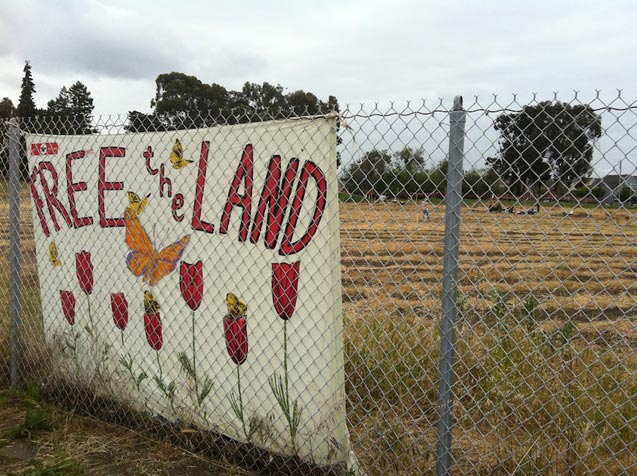 A banner, which led the April 22 march to the tract remains after the May 14 raid.
A banner, which led the April 22 march to the tract remains after the May 14 raid.
That wasn’t enough for UC Berkeley researcher Damon Lisch, who likened the farm occupation to sharing an office with a hostile colleague. Lisch, who conducts research on genetically modified corn in which Novartis has purchased a stake, has been a vocal opponent of the farm, but not of its goals. “I think it would be a terrible precedent if they were allowed to stay. It’s just profoundly un-democratic,” he told reporters last week. “What I hope will happen is that it will be resolved peacefully and people who advocate for urban farming will be allowed a seat at the table.”
UC Berkeley researcher Miguel Altieri came prepared to plant his dry farm tomatoes last Wednesday morning. “We’re going to show that the coexistence of research and the occupation is possible,” he said. “I wanted to contribute to an atmosphere that would promote dialogue toward a peaceful resolution which is basically the commitment of the university to preserve this land for a center for urban agriculture. We need a center for urban agriculture badly.”
When Altieri came to check on his tomatoes on Friday, UC police would not allow him onto the tract.
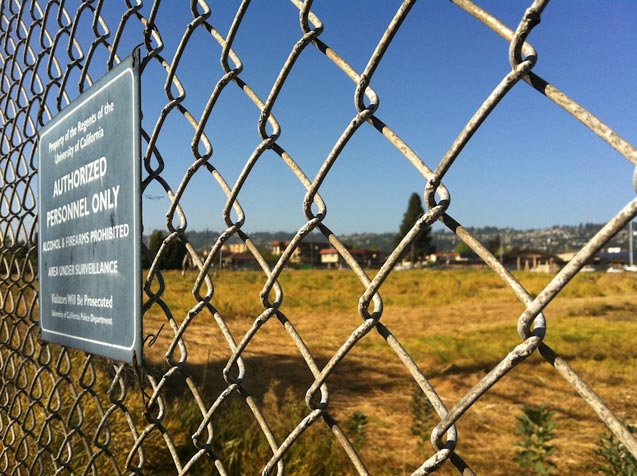 The tract is closed to all following the May 14 raid.
The tract is closed to all following the May 14 raid.
The local community has had mixed reviews for the farm. “We don’t need the farm for education and we definitely don’t need it for food,” wrote a commenter on local news site Albany Patch.
Others support an urban farm on the Gill Tract – just not this one. “I strongly disagree with the tactics that were used. But I think the issues that have been raised are good ones,” said Albany resident and Berkeley graduate student Christopher Church. “I really think there’s a gem here that’s going to be crushed if it keeps going the way it’s going.” Church advocates for a return to the negotiating table with the university and local community. “What I see as the probable conclusion will just end up not benefitting anyone.”
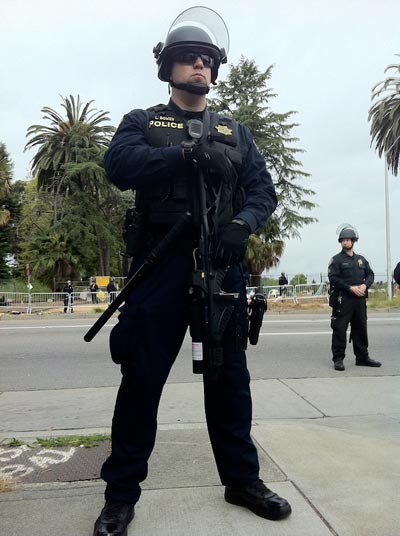 UC police came armed with pneumatic pepper-ball guns on May 14.Others are happy that something finally happened on the Gill Tract after all these years.
UC police came armed with pneumatic pepper-ball guns on May 14.Others are happy that something finally happened on the Gill Tract after all these years.
After the UC shut off water to the farm in the early days of the occupation, local residents mobilized to fill large tanks in order to continue cultivating the crops. After the UC locked the gates to the farm, they helped to lift those huge tanks up and over the chain-link fences.
When the UC Berkeley Dean of the College of Natural Resources Keith Gilless visited the tract last Tuesday, he was visibly angry, pacing and red-faced as he chastised the farmers. Gilless delivered a letter from the university asserting its interest in “finding a way to allow for peaceful coexistence of urban farming and agricultural research on the Gill Tract.” The university once again demanded the occupiers leave, but they did not.
The next day, the UC filed a lawsuit against 14 named and 150 unnamed “Does,” who they allege conspired to take over the tract. The UC dropped one of the defendants after learning that she’s currently studying abroad in Peru. The suit seeks financial damages for the activists’ alleged vandalism as well as the rental value for the land for the duration of the occupation.
 Less lethal shotguns and large pepper-spray canisters for the May 14 raid.The UC reserved two seats for the farmers at a private meeting about the future of the tract, on the condition that farmers first quit the land; they also said they would drop civil litigation and criminal prosecution if the farmers did not attempt to reoccupy. Activists declined, they said, partially out of concern that anything they might say could be used against them in that very prosecution and litigation.
Less lethal shotguns and large pepper-spray canisters for the May 14 raid.The UC reserved two seats for the farmers at a private meeting about the future of the tract, on the condition that farmers first quit the land; they also said they would drop civil litigation and criminal prosecution if the farmers did not attempt to reoccupy. Activists declined, they said, partially out of concern that anything they might say could be used against them in that very prosecution and litigation.
It was a slow and methodical crackdown. UC police visited every day for three weeks before the raid, making a dispersal order and threatening activists with arrest upon each visit. On Wednesday morning, they blocked vehicle traffic into and out of the tract. On Friday morning, the tract was locked to everyone; activists hopped the fences in plain view.
“None of us are interested in having this turn into a police confrontation. We’re all really interested in seeing an urban farm here,” occupier Haddock told me then.
Only by Monday morning did it become the kind of riot-squad raid to which Occupy activists across the country have grown accustomed. UC police came loaded down with tear gas grenade launchers, pepper-ball guns, less lethal projectile shotguns, and other crowd control measures.
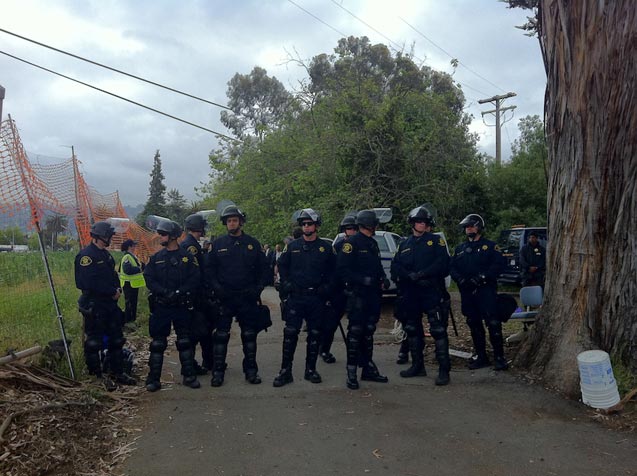 A squad of police block another entrance to the tract on May 14.
A squad of police block another entrance to the tract on May 14.
“You’re dealing with people whose emotions are running high and there’s lots of farm equipment around,” said UCPD Lt. Eric Tejada. “Every piece is a potential weapon. We had to be prepared in case someone picked up a hoe and attacked a police officer.”
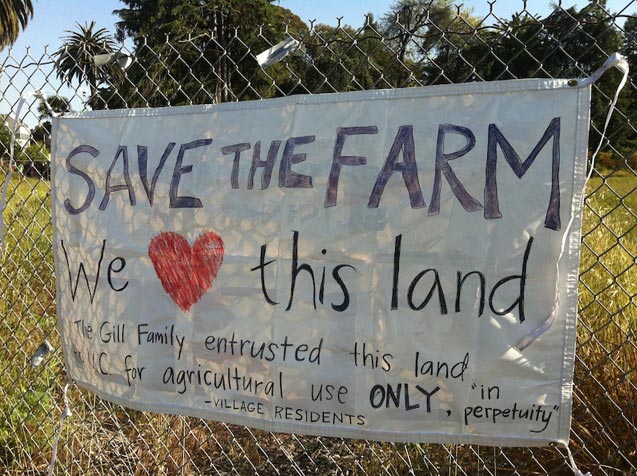 Residents of nearby UC housing express their support for the farm on May 11.
Residents of nearby UC housing express their support for the farm on May 11.
No one did, and the dozens of officers dispatched from eight of the university’s ten campuses arrested only nine people: two for trespassing and seven for remaining at an unlawful assembly across the street. “Watch out,” a UC-hired private security guard told demonstrators. “They’re arresting people here for no reason.”
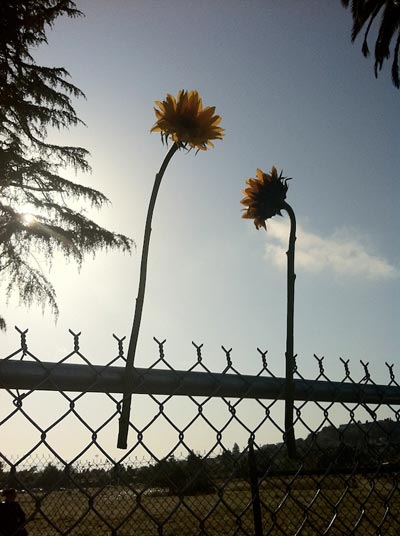 On May 15, farmers marched to the tract with sunflowers, chanting, “Whose farm? The peoples’ farm!”Activists were enthused when they reconverged and marched to the tract on Tuesday. They spoke of other occupiers inspired by this farm now planning land grabs across Northern California in Vallejo, Vacaville, Davis, and beyond. But they hadn’t forgotten their own 70 rows.
On May 15, farmers marched to the tract with sunflowers, chanting, “Whose farm? The peoples’ farm!”Activists were enthused when they reconverged and marched to the tract on Tuesday. They spoke of other occupiers inspired by this farm now planning land grabs across Northern California in Vallejo, Vacaville, Davis, and beyond. But they hadn’t forgotten their own 70 rows.
Wednesday afternoon, the defendants in the lawsuits would all be served with temporary restraining orders from the university, making it a further crime for them to set foot back on that land and water those plants. The ruling drew on gang injunction law in California, essentially labeling Occupy the Farm as a criminal farming organization. But they didn’t know that yet.
Dayaneni addressed the crowd again: “This is a long-term fight. They think their fences can stop us. They think their arrests can stop us. They can’t. We took that space and we can take it back whenever we want.”
We’re not backing down in the face of Trump’s threats.
As Donald Trump is inaugurated a second time, independent media organizations are faced with urgent mandates: Tell the truth more loudly than ever before. Do that work even as our standard modes of distribution (such as social media platforms) are being manipulated and curtailed by forces of fascist repression and ruthless capitalism. Do that work even as journalism and journalists face targeted attacks, including from the government itself. And do that work in community, never forgetting that we’re not shouting into a faceless void – we’re reaching out to real people amid a life-threatening political climate.
Our task is formidable, and it requires us to ground ourselves in our principles, remind ourselves of our utility, dig in and commit.
As a dizzying number of corporate news organizations – either through need or greed – rush to implement new ways to further monetize their content, and others acquiesce to Trump’s wishes, now is a time for movement media-makers to double down on community-first models.
At Truthout, we are reaffirming our commitments on this front: We won’t run ads or have a paywall because we believe that everyone should have access to information, and that access should exist without barriers and free of distractions from craven corporate interests. We recognize the implications for democracy when information-seekers click a link only to find the article trapped behind a paywall or buried on a page with dozens of invasive ads. The laws of capitalism dictate an unending increase in monetization, and much of the media simply follows those laws. Truthout and many of our peers are dedicating ourselves to following other paths – a commitment which feels vital in a moment when corporations are evermore overtly embedded in government.
Over 80 percent of Truthout‘s funding comes from small individual donations from our community of readers, and the remaining 20 percent comes from a handful of social justice-oriented foundations. Over a third of our total budget is supported by recurring monthly donors, many of whom give because they want to help us keep Truthout barrier-free for everyone.
You can help by giving today. Whether you can make a small monthly donation or a larger gift, Truthout only works with your support.